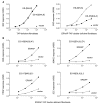ERAAP synergizes with MHC class I molecules to make the final cut in the antigenic peptide precursors in the endoplasmic reticulum
- PMID: 17088086
- PMCID: PMC2746443
- DOI: 10.1016/j.immuni.2006.09.012
ERAAP synergizes with MHC class I molecules to make the final cut in the antigenic peptide precursors in the endoplasmic reticulum
Abstract
The major histocompatibility complex class I molecules display peptides (pMHC I) on the cell surface for immune surveillance by CD8(+) T cells. These peptides are generated by proteolysis of intracellular polypeptides by the proteasome in the cytoplasm and then in the endoplasmic reticulum (ER) by the ER aminopeptidase associated with antigen processing (ERAAP). To define the unknown mechanism of ERAAP function in vivo, we analyzed naturally processed peptides in cells with or without appropriate MHC I and ERAAP. In the absence of MHC I, ERAAP degraded the antigenic precursors in the ER. However, MHC I molecules could bind proteolytic intermediates and were essential for generation of the final peptide by ERAAP. Thus, ERAAP synergizes with MHC I to generate the final pMHC I repertoire.
Conflict of interest statement
The authors declare that they have no conflicts of interest.
Figures







Similar articles
-
The aminopeptidase ERAAP shapes the peptide repertoire displayed by major histocompatibility complex class I molecules.Nat Immunol. 2006 Jan;7(1):103-12. doi: 10.1038/ni1286. Epub 2005 Nov 20. Nat Immunol. 2006. PMID: 16299505
-
ERAAP customizes peptides for MHC class I molecules in the endoplasmic reticulum.Nature. 2002 Oct 3;419(6906):480-3. doi: 10.1038/nature01074. Nature. 2002. PMID: 12368856
-
ERAAP and tapasin independently edit the amino and carboxyl termini of MHC class I peptides.J Immunol. 2013 Aug 15;191(4):1547-55. doi: 10.4049/jimmunol.1301043. Epub 2013 Jul 17. J Immunol. 2013. PMID: 23863903 Free PMC article.
-
Coping with loss of perfection in the MHC class I peptide repertoire.Curr Opin Immunol. 2008 Feb;20(1):82-8. doi: 10.1016/j.coi.2007.12.004. Curr Opin Immunol. 2008. PMID: 18243675 Free PMC article. Review.
-
Immune surveillance for ERAAP dysfunction.Mol Immunol. 2013 Sep;55(2):120-2. doi: 10.1016/j.molimm.2012.10.006. Epub 2013 Feb 20. Mol Immunol. 2013. PMID: 23433779 Free PMC article. Review.
Cited by
-
Chromosome scale genomes of two invasive Adelges species identifies host immunity and developmental gene targets for selective pest control.bioRxiv [Preprint]. 2025 May 3:2024.11.21.624573. doi: 10.1101/2024.11.21.624573. bioRxiv. 2025. PMID: 39605547 Free PMC article. Preprint.
-
Biology of HLA class I associated inflammatory diseases.Best Pract Res Clin Rheumatol. 2024 May;38(2):101977. doi: 10.1016/j.berh.2024.101977. Epub 2024 Jul 31. Best Pract Res Clin Rheumatol. 2024. PMID: 39085016 Free PMC article. Review.
-
ERAP2 Increases the Abundance of a Peptide Submotif Highly Selective for the Birdshot Uveitis-Associated HLA-A29.Front Immunol. 2021 Feb 25;12:634441. doi: 10.3389/fimmu.2021.634441. eCollection 2021. Front Immunol. 2021. PMID: 33717175 Free PMC article.
-
Ankylosing spondylitis: etiology, pathogenesis, and treatments.Bone Res. 2019 Aug 5;7:22. doi: 10.1038/s41413-019-0057-8. eCollection 2019. Bone Res. 2019. PMID: 31666997 Free PMC article.
-
Rationally designed inhibitor targeting antigen-trimming aminopeptidases enhances antigen presentation and cytotoxic T-cell responses.Proc Natl Acad Sci U S A. 2013 Dec 3;110(49):19890-5. doi: 10.1073/pnas.1309781110. Epub 2013 Nov 18. Proc Natl Acad Sci U S A. 2013. PMID: 24248368 Free PMC article.
References
-
- Brouwenstijn N, Serwold T, Shastri N. MHC class I molecules can direct proteolytic cleavage of antigenic precursors in the endoplasmic reticulum. Immunity. 2001;15:95–104. - PubMed
-
- Elliott T, Townsend A, Cerundolo V. Antigen presentation: naturally processed peptides. Nature. 1990;348:195–197. - PubMed
Publication types
MeSH terms
Substances
Grants and funding
LinkOut - more resources
Full Text Sources
Other Literature Sources
Molecular Biology Databases
Research Materials

